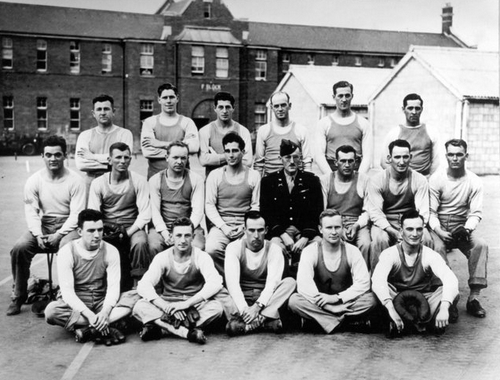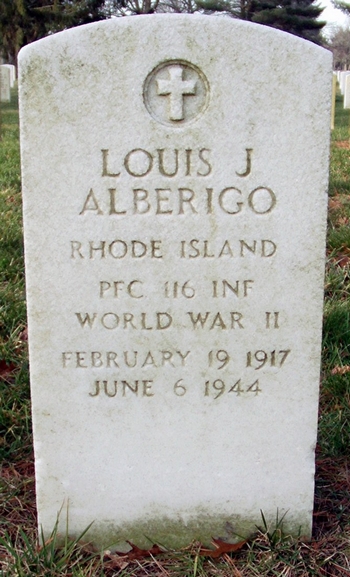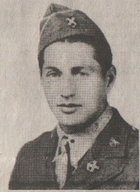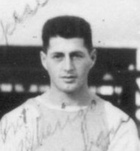Lou Alberigo
| Date and Place of Birth: | February 19, 1917 Cranston, RI |
| Date and Place of Death: | June 6, 1944 Omaha Beach, Normandy, France |
| Baseball Experience: | Semi-Pro |
| Position: | Third Base |
| Rank: | Private First Class |
| Military Unit: | 2nd Battalion, F Comany, 116th Infantry Regiment, 29th Infantry Division US Army |
| Area Served: | European Theater of Operations |
"He was one of those guys who could play any position,” recalls Florio Ise, who grew up with Lou Alberigo in Cranston, Rhode Island. “If you asked him to catch, he would catch. Centerfield, leftfield, you name it, he could play it. He was a big, muscular, big-boned guy. He was fearless. There was nothing he wouldn't do."
Louis J. Alberigo was born in Cranston, Rhode Island on February 19,
1917. He graduated from Pontiac Grammar School, served in the 243rd
Coastal Artillery Regiment of the National Guard, and went to work for
the local Fruit of the Loom mill. Alberigo - rated one of the best
players in local diamond history - was playing semi-pro baseball with
the Pontiac Men’s Club and the Dyers Federation, attracting the
attention of a St Louis Cardinals’ scout. But on September 16, 1940, the
243rd Coastal Artillery Regiment was mobilized and sent to Fort Adams at
Narrangansett Bay. Alberigo, remembered as a big, quiet guy who always
played with the peak of his cap turned upwards, was the third baseman for the Fort Adams team in Newport's Sunset Baseball League in 1941 - his .417
batting average led the league, and the Fort Adams team was crowned
First Corps Area champions when they defeated Fort Constitution, 12-3,
at Fenway Park in Boston on September 13, 1941. Alberigo made an
outstanding defensive play in that game. With runners on first and
second, he snared a hard-hit grounder, tagged the runner from second and
threw to second to complete the double play. Major league scouts were in
the crowd at Fenway that day but any thoughts of playing baseball
professionally had to be put on hold until after the war was over.
Alberigo was later sent to England with the 116th Infantry Regiment of the
29th Infantry Division in 1943, where he would be involved in military
training in preparation for D-Day. At the end of September 1943, the
26-year-old third baseman played for the 116th Infantry Regiment Yankees
in the ETO World Series – a four-day, 16-team event to find the US Armed
Forces champion of Europe. The 116th were a dark horse team who beat all
opposition to reach the September 30 final against Fighter Command
Headquarters. Alberigo, batting cleanup and playing third base, scored
two runs in the Yankees’ 6-3 championship win.
Eight months later, troops of the 116th Infantry Regiment were the first
to face the devastating enemy barrage at Omaha Beach in Normandy on June
6, 1944. Men leapt from landing craft into waist-deep water and an
onslaught of deadly accurate machine gun and mortar fire that virtually
annihilated the initial waves of the 116th. Among the 2,200 men who lost
their lives that day was 27-year-old Private First Class Louis Alberigo.
Shortly after the war the young Rhode Island athlete’s body was returned
to the United States and Louis Alberigo is now buried at Long Island
National Cemetery in Farmingdale, New York.

116th Infantry Regiment Yankees in England in
1943
(Lou Alberigo is back row, third from left)

Date Added June 4, 2012 Updated July 5, 2013
Baseball's Greatest Sacrifice is associated with Baseball Almanac
Baseball's Greatest Sacrifice is proud to be sponsored by



